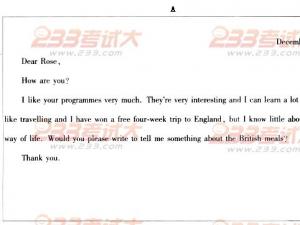D
Besides entertainment and beautiful lanterns, another important part of the Lantern Festival, or Yuanxiao Festival is eating small dumpling balls made of glutinous rice flour. We call these balls Yuanxiao or Tangyuan. Obviously, they get the name from the festival itself. It is said that the custom of eating Yuanxiao originated during the Eastern Jin Dynasty in the fourth century, then became popular during the Tang and Song periods.
The fillings inside the dumplings or Yuanxiao are either sweet or salty. Sweet fillings are made of sugar, walnuts, sesame(芝麻), osmanthus flowers(桂花), rose petals, sweetened tangerine(橘子) peel, bean paste, or jujube paste(枣子酱). A single ingredient or any combination can be used as the filling. The salty variety is filled with minced meat(肉末儿), vegetables or a mixture.
The way to make Yuanxiao also varies between northern and southern China. The usual method followed in southern provinces is to shape the dough of rice flour into balls, make a hole, insert the filling, then close the hole and smooth out the dumpling by rolling it between your hands. In North China, sweet or nutmeat stuffing is the usual ingredient. The fillings are pressed into hardened cores, dipped lightly in water and rolled in a flat basket containing dry glutinous rice flour. A layer of the flour sticks to the filling, which is then again dipped in water and rolled a second time in the rice flour. And so it goes, like rolling a snowball, until the dumpling is the desired size.
The custom of eating Yuanxiao dumplings remains. This tradition encourages both old and new stores to promote their Yuanxiao products. They all try their best to improve the taste and quality of the dumplings to attract more customers.
51. Which of the following is NOT true?
A. The custom of eating Yuanxiao dates back to the fourth century.
B. Sugar, rose petals and minced meat are all fillings of Yuanxiao.
C. Sweet Yuanxiao is usually made in southern China.
D. People in northern China usually make Yuanxiao by rolling it like a snowball.
52. Which country does the Lantern Festival come from?
A. China.
B. South Korea.
C. Jin Dynasty.
D. Tang and Song periods.
53. Choose the right order of making Tangyuan in southern provinces.
① make a hole and insert the filling
② roll the dough between your hands
③ shape the dough of rice flour into balls
④ close the hole
⑤ prepare some rice flour
A. ⑤③②①④
B. ③⑤①②④
C. ③①④②⑤
D. ⑤③①④②
54. What is the best title of this passage?
A. The Lantern Festival.
B. The ingredients of Yuanxiao.
C. The difference between Yuanxiao and Tangyuan.
D. China's traditional food—Yuanxiao.
55. Why do we eat Yuanxiao today?
A. Because it' s a tradition.
B. Because it' s a kind of tasty food.
C. Because we love our country.
D. Because this food can make money.
E
Dogs wag(摇摆) their tails in different directions depending on whether they are excited and wanting to move forward, or threatened and thinking of moving back, a study has found.
Researchers in Italy examined the tail wagging behavior of 30 dogs, catching their responses to a range of stimuli(刺激物) with video cameras. To conduct the study they chose 15 male dogs and 15 female ones aged between one and six years. The dogs were all family pets whose owners had allowed them to take part in the experiment at Bari University. The dogs were placed in a large wooden box with an opening at the front to allow for them to view various stimuli. They were tested one at a time.
The researchers led by Professor Giorgio Vallortigara of the University of Trieste found that when the dogs were shown their owners--a positive experience--their tails wagged energetically to the
right side. When they were shown an unfamiliar human they wagged to the right, but with somewhat less enthusiasm. The appearance of a cat again caused a right-hand side wag, although with less intensity again. The appearance of a large unfamiliar dog, similar to a German shepherd, changed the direction of tail wagging to the left. Researchers supposed the dog was thinking of moving back. When the dogs were not shown any stimuli they tended to wag their tails to the left, suggesting they preferred company. While the changes in the tail wagging were not easily noticed without the aid of video, it was thought that the findings could hel
